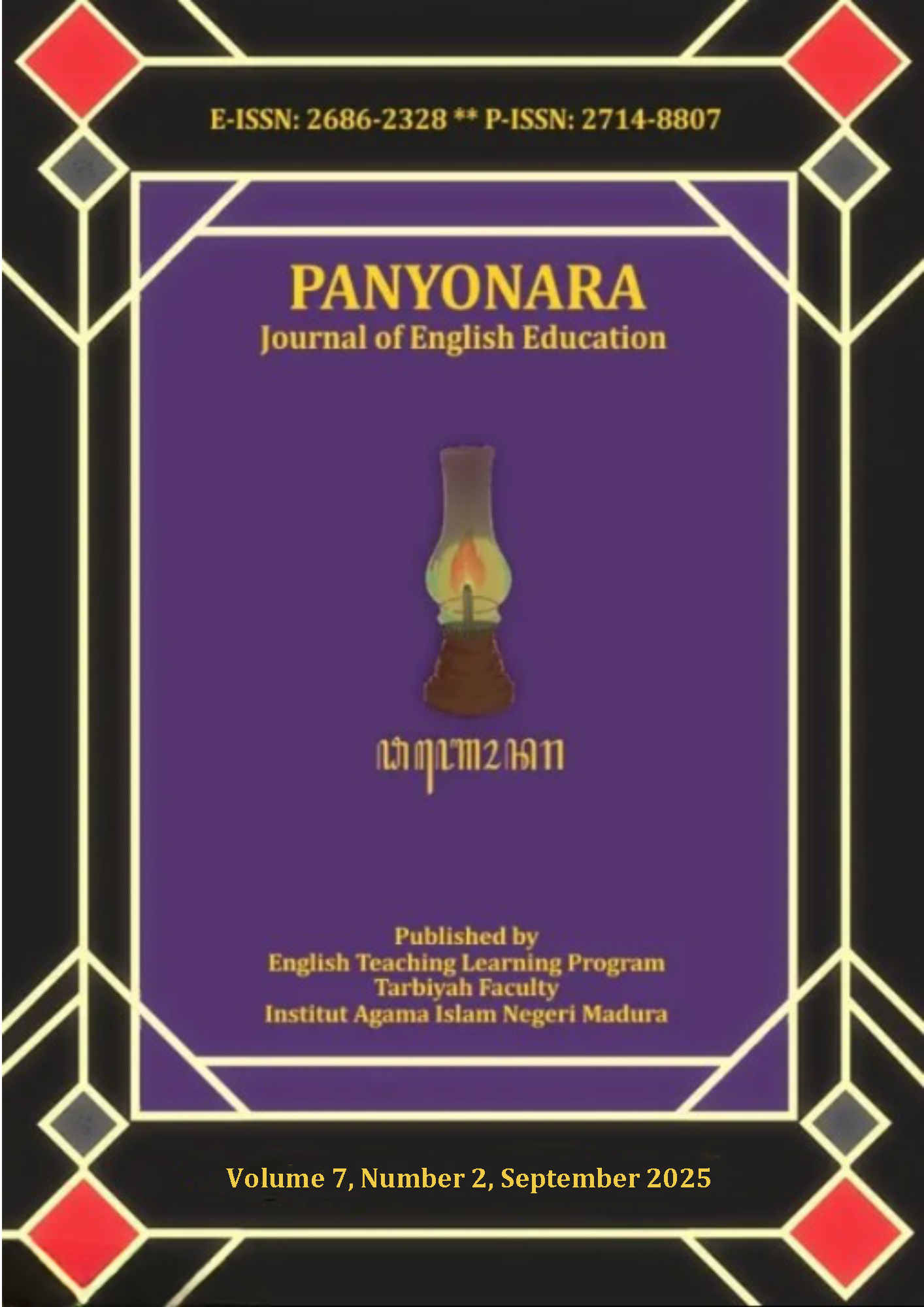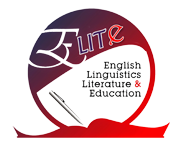Inclusive English Teaching Strategies at SLBN 1 Tanjungpinang: Blind vs deaf students
 Abstract views: 173
,
Abstract views: 173
,
 PDF downloads: 87
PDF downloads: 87
Abstract
This study focuses on inclusive English teaching strategies for blind and deaf students at SLBN 1 Tanjungpinang, emphasizing that education must be ensured for all students, including those with special needs. The purpose of the study is to explore differentiated instructional approaches that align with the sensory modalities of each group to enhance learning outcomes. . Using a qualitative case study approach, the study employs field-based observations and reflective documentation as research methods. The study compares auditory and tactile strategies for blind students with visual-based methods for deaf students. The main findings indicate that blind students benefit from interactive storytelling, structured verbal activities, and tactile materials such as Braille, while deaf students gain from vocabulary modelling, sign language, and visual aids. The study concludes that adaptive pedagogy, tailored to sensory strengths, is critical for competency-based and inclusive English education in special schools, despite challenges like limited resources and the need for continuous teacher training.
Downloads
References
Abdallah, M. M. S. (2017). Towards improving content and instruction of the ‘TESOL/TEFL for Special Needs’ course: an action research study. Educational Action Research, 25(3), 420–437. https://doi.org/10.1080/09650792.2016.1173567
Adi, S. S., Unsiah, F., & Fadhilah, D. (2017). Teaching special students: English lessons for deaf students in Indonesian special junior high schools. International Journal of Education and Research, 5(12), 121–136. Retrieved from https://www.ijern.com/journal/2017/December-2017/10.pdf
Bell, S. (2010). Project-Based Learning for the 21st Century: Skills for the Future. The Clearing House: A Journal of Educational Strategies, Issues and Ideas, 83(2), 39–43. https://doi.org/10.1080/00098650903505415
Beiranvand, F., & Mall-Amiri, B. (2018). The Comparative Effect of Using Listening Strategies on Reflective and Impulsive Visually Impaired Learners’ Listening Comprehension. The Journal of English Language Pedagogy and Practice, 11(22), 54–73.
Boltenkova, J., Nevolina, A., Koksharov, V., Li, S., Rasskazova, T., Tkachuk, G., & Baliasov, A. (2020). Teaching Efl To Blind and Visually Impaired Students: an Overview. ICERI2020 Proceedings, 1(June 2023), 5616–5623. https://doi.org/10.21125/iceri.2020.1209
Braun, V., & Clarke, V. (2006). Using thematic analysis in psychology. Qualitative Research in Psychology, 3(2), 77–101. https://doi.org/10.1191/1478088706qp063oa
Farah, A., Agustiyawati, A., Rizki, A., Widiyanti, R., Wibowo, S., Tulalessy, C., … Maryanti, T. (2022). Panduan Pelaksanaan Pendidikan Inklusif. Kepala Pusat Kurikulum Dan Pembelajaran Badan Standar, Kurikulum, Dan Asesmen Pendidikan Kementerian Pendidikan Kementerian Pendidikan, Kebudayaan, Riset, Dan Teknologi, 1–44. Retrieved from https://kurikulum.kemdikbud.go.id/wp-content/uploads/2022/08/Panduan-Pelaksanaan-Pendidikan-Inklusif.pdf
Fera Zasrianita, Jelita Zakaria, Tea Aprilinola, Iis Avitha Sari, Reza Meltavia, & Hariyanto Supriadi. (2024). Kemampuan Menulis Teks Prosedur Kelas Vii C Smp Negeri 9 Kota Bengkulu. Journal of Language and Literature Education, 1(1), 20–28. https://doi.org/10.59407/jolale.v1i1.536
Fitriyah, F., & Bisri, M. (2023). Pembelajaran Berdiferensiasi Berdasarkan Keragaman Dan Keunikan Siswa Sekolah Dasar. Jurnal Review Pendidikan Dasar : Jurnal Kajian Pendidikan Dan Hasil Penelitian, 9(2), 67–73. https://doi.org/10.26740/jrpd.v9n2.p67-73
Habe, H., & Ahiruddin, A. (2017). Sistem Pendidikan Nasional. Ekombis Sains: Jurnal Ekonomi, Keuangan Dan Bisnis, 2(1), 39–45. https://doi.org/10.24967/ekombis.v2i1.48
Hidayah, J.-, & Morganna, R.-. (2019). Fulfilling the Needs of Diverse Students: Teaching Strategies for Efl Inclusive Classrooms. Suar Betang, 14(2). https://doi.org/10.26499/surbet.v14i2.135
Humphries, T., Kushalnagar, P., Mathur, G., Napoli, D. J., Padden, C., Rathmann, C., & Smith, S. (2014). Bilingualism: A Pearl to Overcome Certain Perils of Cochlear Implants. Science, 21(2), 107–125.
Jason, L. A., & Glenwick, D. S. (2016). HANDBOOK OF METHODOLOGICAL APPROACHES TO COMMUNITY-BASED-RESEARCH. 17, 302.
Kasumagić, L., & Pintol, A. (2021). University of Sarajevo Faculty of Philosophy Department of English Language and Literature. 109.
Maurya, H. M. (2016). Strategies for Teaching Students with Visual Impairment. An International Multidisciplinary Refereed Research Journal, 7(1), 90–96. Retrieved from https://www.researchgate.net/publication/353013224
Mesmoudi, K. (2020). THE IMPACT OF E-LEARNING PROGRAMS ON DEAF AND ON DEAF AND HARD OF HEARNING LEARNERS IN TEFL SITUATION ITUATION The. Science, i, 91.
Nonci, J., Ruswiyani, E., & Muin, Z. I. (2022). The Implementation of Visual Media in Teaching English Literacy to The Deaf Students of Tenth Grade at Small 1 Pangkep. Journal of Research and Multidisciplinary, 5(1), 552–557. Retrieved from http://journal.alhikam.net/index.php/jrm
Nover, S. M., & Andrews, J. F. (2000). Critical Pedagogy in Deaf Education: Teachers’ Reflections on Creating a Bilingual Classroom for Deaf Learners. Year 3 Report (1999-2000). USDLC Star Schools Project Report No. 3.
Nugraheni, A. S., Husain, A. P., & Unayah, H. (2023). Optimalisasi Penggunaan Bahasa Isyarat Dengan Sibi Dan Bisindo Pada Mahasiswa Difabel Tunarungu Di Prodi Pgmi Uin Sunan Kalijaga. Jurnal Holistika, 5(1), 28. https://doi.org/10.24853/holistika.5.1.28-33
Prystiananta, N. C., & Noviyanti, A. I. (2025). Enhancing EFL Instruction in Special Needs Education: Integrating Multimodal Digital Tools and Deep Learning Strategies. Voices of English Language Education Society, 9(1), 96–108. https://doi.org/10.29408/veles.v9i1.29411
Shaaban, S. S. A., & Shaat, M. A. (2022). A Scenario-Based Learning Approach for Enhancing Al-Azhar University-Gaza Student-Teachers’ TEFL Practices in Inclusive Education Classes. Journal of Language Teaching and Research, 13(4), 740–748. https://doi.org/10.17507/jltr.1304.06
Soumia, T., & Mohammed, N. (2021). the Role of Auditory and Tactile Educational Material in Teaching English To Visually Impaired Students the Role of Auditory and Educational Material in Teaching English To Visually Impaired Students. Science, 13(March).
Special, I., Schools, N., Amirabadi, S. J., Alavi, S. M., & Karami, H. (2024). Methods and Challenges of Teaching English to Blind and Visually-Impaired Students at the Iranian Special Needs Schools. Foreign Language Research, 14(3), 403–414. https://doi.org/http//doi.org/10.22059/jflr.2024.377172.1136.
Stinson, C. (2018). Beyond compliance: An approach to serving English language learners with disabilities. TESOL Journal, 9(4), 1–8. https://doi.org/10.1002/tesj.405
Tomlinson, C. A. . (2001). How to differentiate instruction in mixed-ability classrooms. Pearson/Merrill Prentice Hall.
Utami, R. P., Suharyadi, S., & Astuti, U. P. (2021). EFL Teachers’ Problems and Solutions in Teaching English to Students with Intellectual and Developmental Disability. IJELTAL (Indonesian Journal of English Language Teaching and Applied Linguistics), 6(1), 173. https://doi.org/10.21093/ijeltal.v6i1.912
Wahyudin, W., Qobus, M. S., Fatimah, N. S., Riza, L. S., & Adedokun-Shittu, N. A. (2024). The Implementation of Project-Based Learning (PBL) with ADDIE Model to Improve Students’ Creative Thinking Ability. Elinvo (Electronics, Informatics, and Vocational Education), 9(2), 283–293. https://doi.org/10.21831/elinvo.v9i2.77240
Young, D., Schaefer, M. Y., & Lesley, J. (2019). Accommodating Students with Disabilities Studying English as a Foreign Language (Practice Brief). Journal of Postsecondary Education and Disability, 32(3), 311–319. Retrieved from https://www.proquest.com/scholarly-journals/accommodating-students-with-disabilities-studying/docview/2396836728/se-2?accountid=12543%0Ahttps://libkey.io/libraries/2401/pdfexpress/openurl?sid=ProQ:&issn=23797762&volume=32&issue=3&title=Journal+of+Postseco
The journal uses an Open Access policy under a Creative Commons Attribution-NonCommercial 4.0 International License. Authors who publish with this journal agree to the following terms:
- Authors retain copyright and grant the journal right of first publication with the work simultaneously licensed under a Creative Commons Attribution License that allows others to share the work with an acknowledgment of the work's authorship and initial publication in this journal.
- Authors are able to enter into separate, additional contractual arrangements for the non-exclusive distribution of the journal's published version of the work (e.g., post it to an institutional repository or publish it in a book), with an acknowledgment of its initial publication in this journal.
- Authors are permitted and encouraged to post their work online (e.g., in institutional repositories or on their website) prior to and during the submission process, as it can lead to productive exchanges, as well as earlier and greater citation of published work.
















